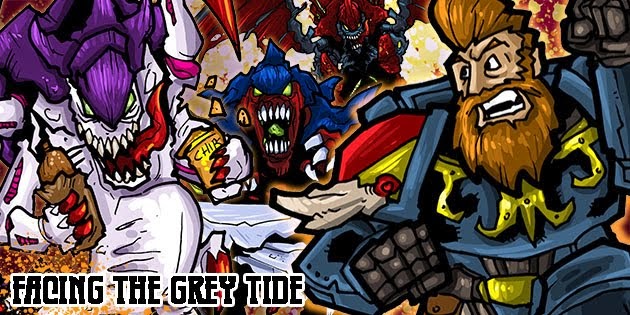Continuing on with the Horus Heresy review series, the next up is the second short story collection. This collection contains nine short stories spanning a majority of the legions. With these short stories, some are cool from a story standpoint, but in the end are fairly inconsequential, while others might introduce something for following novels, or follow a new aspect of an old novel. As always, spoilers may follow.
The first story is "Rules of Engagement" by Graham McNeill. This story begins with Roboute Guilliman writing what we assume to be the Codex Astartes. The remainder of the story follows Remus Ventanus of the 4th Company as he meticulously follows the rules written in the Codex Astartes, even when he doesn't understand why. His utter devotion to his Primarch's text leads to victory after victory in real and practiced engagements, until finally he is defeated by Guilliman posing as the Warmaster.
The story is interesting as it demonstrates Guilliman's tactical genius and ability to describe rote actions that will lead to victory in all but the most extreme circumstances. The story is also interesting because Ventanus's unswerving devotion to the text is seen as extreme by his fellow Ultramarines. This of course, is a strict contrast to 40k Ultramarines, to whom any deviation from the Codex Astartes is a punishable crime.
Next is "Liar's Due," by James Swallow. This story is one of few to not explicitly follow any of the Legionnes Astartes, and instead, tells the story of how an agent of the heresy (possibly of Alpha Legion or Word Bearers) turns a planet from the Imperium into loyalty to the Warmaster through misinformation.
The third story is "Forgotten Sons," by Nick Kyme. The story follows a Salamander, survivor of the Istvaan Dropsite Massacre and a wounded Ultramarine as they visit the planet Bastion, as emissaries for the Imperium, vying against an embassador from the Warmaster. In the course of arguing back and forth, Heka'Tan, the Salamander discovers that Iron Warriors have infiltrated the planet and set various explosives in key locations to more or less destroy the planet. It's a fairly action packed story which also is the first in the series to provide some insight into the Salamanders, which was interesting.
Next on the hit parade is "The Last Remembrancer" by John French. This story tells of one of the founders of the remembrancer order, who defied the dissolution of the Remembrancers and went to follow Horus's path in order to record it. He was found imprisoned on a traitor ship and brought to a prison in the Sol system where he is interrogated by Rogal Dorn and Iacton Qruze. In the course of the interrogation, it comes up just how harmful Horus's rebellion is to the Imperial ideals, making Dorn doubt they ever existed. This story, to me, gets to the root of the difference between the pre-heresy Imperium and the 40k Grimdark universe.
After that story is "Rebirth" by Chris Wraight, which follows a Thousand Son who has returned to Prospero after the Wolves' judgement, and is then accosted by Kharn and the World Eaters. Kharn and his group is there to interrogate any Thousand Sons who return to Prospero to gauge their loyalties, but they predictably come to blows.
Next is "The Face of Treachery" by Gav Thorpe, which I've come to realize is a prequel to Deliverance Lost. The story follows a Raven Guard commander hoping to save his Primarch from Istvaan V while avoiding the attention of patrolling World Eaters. The evacuation of survivors is aided by the intervention of Alpha Legionnaires who had infiltrated the World Eaters and cut the chain of command on a ship that was seeking to destroy the Raven Guard before they could escape. This story definitely sets the tone and precedent for Deliverance Lost, and is useful background for that book.
The next entry was "Little Horus" by Dan Abnett. This story was interesting as it follows Horus Aximand and how he is haunted by his betrayal of Loken. I liked this one as there is some possible foreshadowing of a showdown between Little Horus and his former friend, Loken. It's also interesting because while many of the traitors seem implacable and remorseless, there is still that inkling of doubt with Little Horus about his decision to side with Abbaddon and follow Erebus's lead.
The penultimate entry in this collection is "The Iron Within" by Rob Sanders, which catalogs a loyal Iron Warriors contingent standing against their traitor brothers, illustrating the effectiveness of the Iron Warriors' fortifications. The conflict rages for months, drawing valuable resources away from arguably more important endeavors for Horus and his attempted coup. In the end, the loyal Iron Warriors win a great victory through ingenuity, and the story foretells that Dantioch, the protagoinst Iron Warrior, will help shore up the defenses of the Imperial Palace, but also that no matter how well it is defended, it will fall.
The final entry in the collection is "Savage Weapons" by Aaron Dembski-Bowden, which follows the Dark Angels, particularly the Lion, facing off against the Night Lords and Konrad Curze. The story shows an encounter between the two Primarchs and their champions. I find the Lion an interesting character, if not particularly likeable, so it was interesting to see his interactions a bit more directly, as well as only the second look in the series at the Night Lords.
In the end, the collection was interesting, even if most of the stories didn't contain much vital information about the Heresy. I will admit, this review took me longer to write than it did to read the collection - it's hard to dig into nine stories in one post while not writing a novel myself. It also probably doesn't help that I've read the next two books in the series already (so look for those soon).


No comments:
Post a Comment